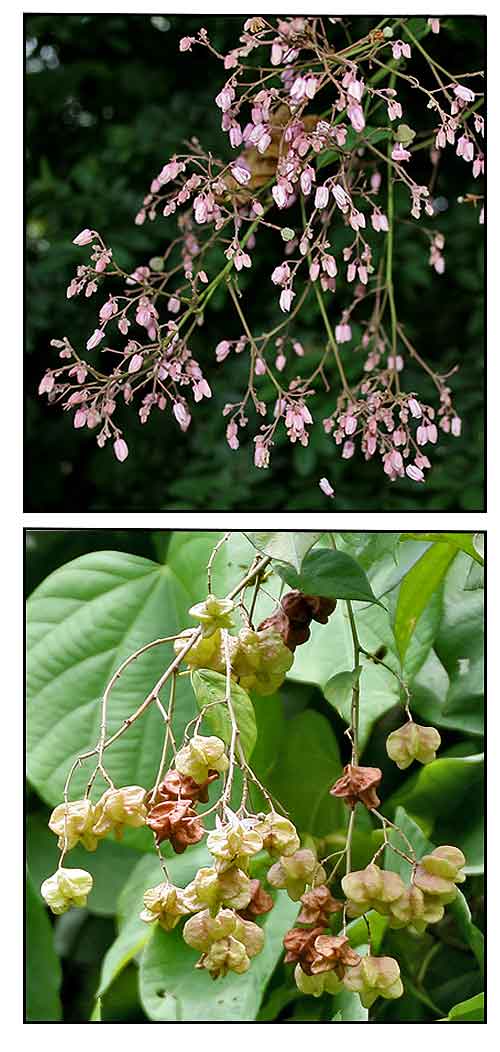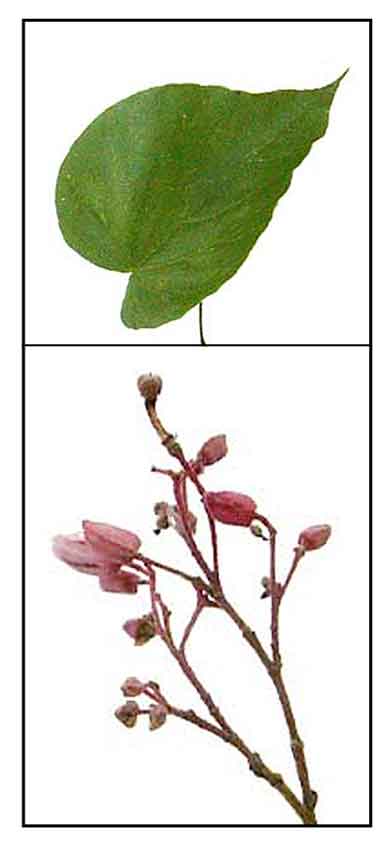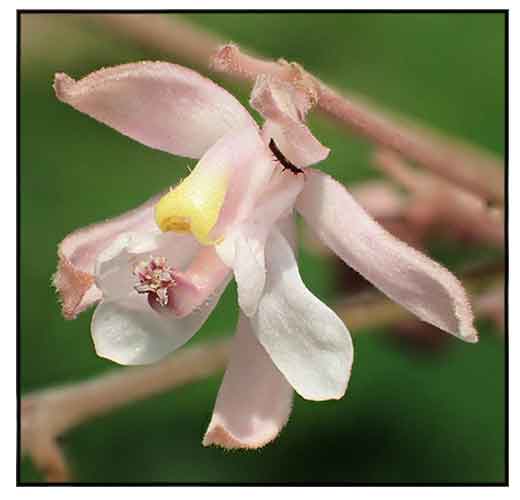|
 Gen info Gen info
- Kleinhovia hospita is an evergreen, tropical tree native to Indonesia, Malaysia, and other parts of tropical Asia and the Pacific. It is monotypic: it is the only species in the genus Kleinhovia.
-
Etymology: The genus name Kleinhovia honors Christiaan Kleynhoff (died 1777), a German doctor and botanist with the Dutch East Indies Company. He sent plant collections to Linnaeus, who subsequently named the genus after Kleynhoff. The species epithet derives from Latin "hospes" (guest) meaning "hospitable " or "friendly", perhaps alluding to the tree's frequent association with human riverside settlements.
 Botany Botany
• Tan-ag is a tree growing up to
15 meters high with a dense rounded crown. Leaves are simple and alternate, broadly ovate, 10 to 20 centimeters long, with
pointed tip and heart-shaped base, with petioles 5 to 20 centimeters long. Flowers are pink, about
8 millimeters long, borne on panicles 20 to 40 centimeters long, terminating the branches.
Fruit is a thin-walled, 5-lobed, inflated capsule about 2 centimeters long, each locule containing 1 to 2 seeds. Seeds are globose, whitish, and warty.
• Kleinhovia hospita is an evergreen, bushy tree growing up to 20 m high, with a dense rounded crown and upright pink sprays of flowers and fruits. Leaves are simple and alternate; stipules are ensiform to linear, about 8 mm long; petioles are 2.5–30 cm long; the leaf-blade is ovate to heart-shaped, glabrous on both sides, with the apex pointed. Secondary veins occur in 6-8 pairs, palmately nerved. Flowers are terminal, in loose panicles protruding from the crown; flowers are about 5 mm wide, colored pale pink; pedicels are 2–10 mm long; bracteoles are lanceolate, 2–4 mm long, pubescent; gynandrophores are 4–7 mm long, pubescent; there are 5 sepals, linear lanceolate, 6–8 mm long, pink, tomentose; 5 petals, inconspicuous, the upper one being yellow; 15 stamens, monaldelphous, 8–15 mm long, staminal tube broadly campanulate, adanate to gynandrophore, 5-lobed, each lobe having 3 anthers and alternating with staminodes; the anthers are sessile and extrorse; pistil occur with a 5-celled, pilose ovary, one style and a capitate, with a 5-lobed stigma. K. hospita flowers throughout the year. Fruits are round, five-lobed, thin-walled, membranous capsules, 2–2.5 cm in diameter, loculicidally dehiscent, each locule having 1–2 seeds. (Fruits often start in the third year after planting.) Seeds are globose, whitish, warty and exalbuminous. Fruits are more conspicuous than the flowers because of their abundance and size. (27)
Distribution
- Native to the Philippines. (26)
-
Common in thickets, secondary
forests, and deserted clearings at low and medium altitudes throughout the Philippines.
- Also native to Bangladesh, Caroline Is., Christmas I., Fiji, Hainan, India, Lesser Sunda Is., Malaya, Nansei-shoto, Samoa, Society Is., Solomon Is., Taiwan, Tonga, Vanuatu, Vietnam. (8)
 Constituents Constituents
- Yields triterpenes (beta-amyrin, bauerenol, baurenol acetate, betulin, lupeol acetate), fatty acids, flavonol (kaempferol, nicotiflorin, quercetin, rutin, vitexin), coumarin (scopoletin), steroid (beta-sitosterol).
-
Leaves and bark contain cyanogenic
compounds that provide lice-killing properties.
- Extracts of leaves have shown anti-tumor activity against mice-sarcoma.
- Scopoletin, kaempferol and quercetin have been isolated from the leaves.
- Study isolated four cycloartane triterpenoid alkaloids, kleinhospitines A-D. (see study below)
(6)
- Study of chloroform extract of stem bark isolated scopoletin, 7-hydroxy-6-methoxy coumarin (1) together with β-sitosterol (2).
(see study below) (11)
- Study of seeds for amino acid composition (TPI [g/16gN]) yielded aspartic acid + asparagine, glutamic acid + glutamine (25.69), serine, histidine, gycine (8.02), threonine, arginine, alanine, tyrosine (7.18), methionine, valine, phenylalanine, isoleucine, leucine, lysine (8.03). (see study below) (14)
- Phytochemical screening of ethanolic extract of leaves yielded alkaloid, flavonoid, saponin, tannin, and steroids, with an absence of triterpenoid. (18)
- Study of K. hospita isolated two new cycloartane triterpenoids, (23R)-21,23:23,27- diepoxycycloarta -1,24-diene-3,27-dione (1) and (3α)-(α-L-arabinopyranosyloxy)-1α -hydroxy-23-oxocycloartan -28-oic acid (2), together with six known pentacyclic triterpenoids, 3–8, and five known C29 steroids, 9–13.(19)
Properties
- Lice-killing.
- Considered anti-tumor, antibacterial (weak), chronotropic, histaminergic, spasmolytic.
- Studies have shown hepatoprotective, cardioprotective, corrosion inhibition, antidiabetic, antibacterial, cytotoxic, Anopheles larvicidal properties.
Parts utilized
Bark and leaves.
 Uses Uses
Edibility
- Young leaves, sprouts, and flowers
eaten as vegetable.
Folkloric
- Decoction of leaves
used for scabies and itching and all forms of dermatitis.
- In Agusan del Sur, used for dyspepsia, cough, asthma.
-
Used for psoriasis. (23)
- Crush leaves rubbed on forehead to relieve headache.
- Bark and leaves used in Malaya as hair wash to destroy lice.
- In eastern Malaysia juice of leaves used as eyewash.
- In Malaya, Indonesia and
Papua, New Guinea, used to treat scabies.
- In Papua, New Guinea and the Solomon Islands, a preparation from the cambium used to treat pneumonia. Leaves used as hair-wash to get rid of lice.
- In Indonesia, used for liver diseases.
- In Sulawesi, boiled leaves drunk for stomachaches, liver diseases, and various internal diseases. The leaves used as repellent against ticks. (12)
- In Thailand, bark used to treat skin irritations.
- Bark is scraped, mixed with water, filtered and drunk to relieve coughs and tuberculosis.
- Crushed leaf rubbed on skin diseases and rubbed on the forehead to relieve headaches.
- Juice from young leaves, mixed in water, drunk to treat bee stings.
Others
- Fiber: Bast fibers used for
tying or rope making used for tethering livestock. The rope is durable
during rainy weather.
- Wood: Straight branches used for making ornamental pieces, house rafters, and poles for stakes. (10)
- Fuelwood: Considered a good fuel wood. Energy value of the wood is about 19,000 kJ/kg. (10)
- Poison: In Marinduque, bark is reportedly used to poison eels.
- Repellent: Leaves are used as rice field insects repellent.
- Ornamental: Ornamental use for its pink-colored panicles.
- Poison: Bark and leaves reportedly poisonous. In Marinduque, used to poison eels. (24)
- Fiber composite reinforcement: Bark has good potential as reinforcement for Fiber Reinforced Composites because of high mechanical strength. (see study below) (28)
Studies
• Cycloartane Triterpenoids / Hepatoprotective: Study isolated four new cycloartane triterpenoids with known gardenolic acid from K. hospita. The compounds showed promising hepatoprotective effects on nitrofuratoin-induced cytotoxicity in human liver-derived Hep G2 cells. (2)
• Antioxidant / Cytotoxicity: Study of leaf extracts of K. hospita showed potent antioxidant activity (96% compared to vitamin C, 98 %) using DPPH assay and moderate dose-dependent cytotoxicity on HepG2 liver cancer cells. (3)
• Kleinhospitines / Triterpenoid Alkaloids / Hepatoprotective: Study isolated Kleinhospitines A-D, four unprecedented cycloartane triterpenoid alkaloids isolated as two mixtures of C-23 epimers. The two mixtures showed hepatoprotective activity against H2O2-induced oxidative dames on primary cultured rat hepatocytes. (6)
• Cytotoxicity / Brine Shrimp Lethality Test: Study evaluated the mortality effects and Median Lethal concentrations of KH extracts on Artemia salina through the brine shrimp lethality test. Results showed weak to moderate toxicity with LC50 of 698.54 µg/mL for the decoction and 452.03 µg/mL for the ethanol extract. (9)
• Scopoletin / Stem Bark: Study of chloroform extract of stem bark yielded scopoletin and ß-sitosterol. Scopoletin showed moderate activity against Artemia salina with LD50 of 569.64 µg/ml. Scopoletin can also be used as antihypertensive, anti-inflammatory, antiallergenic, and inhibitor of prostaglandin synthetase. (11)
• Scopoletin / Hypoglycemic / Hypolipidemic: Scopoletin, a coumarin derivative, found K. hospita, was evaluated for hypoglycemic and hypolipidemic activity in STZ-induced diabetic Wistar albino rats. Results showed scopoletin at 1 mg/kg dose showed significant antihyperglycemic and antihyperlipidemic activity. (13)
• Fractionation and Chemical Studies / Seed Protein: Fractionation of protein from seeds yielded a total of 15 amino acids including nine essential amino acids. The seed protein yielded high amounts of albumin and gluteliin fractions. Results suggest that the K. hospital seed protein may be used as food supplement after proper toxicological screening. (see constituents above) (14)
• Fatty Acid Composition / Antibacterial / Leaf Oil: GC-MS analysis of leaf oil evaluated yielded 19 fatty acids, accounting for 80.47% of total FA and 13 unidentified compounds. Predominant fatty acids were palmitic acid (17.97%), linoleic acid (8.05%), oleic acid (7.87%), and stearic acid (7.79%). Antibacterial evaluation of the oil against Gram-positive Bacillus subtilis and B. licheniformis and Gram-negative E. coli and Acinetobacter junii showed MICs of 61.75 µg/ml, 60.02 µg/ml, 35.75 µg/ml, 38.04 µg/ml, respectively. (15)
• Hepatoprotective / Cardioprotective / Doxorubicin Toxicity: Doxorubicin is a potent chemotherapeutic agent, which may cause cardiac, hepatic and renal dysfunction. Study evaluated the protective effects of Kleinhovia sp. extract (100, 250 and 500 mg;kg orally for 5 days) against Doxorubicin (DOX) acute toxicities in male rats. Results showed the extract protected rats from liver toxicity at any dose given, while only a dose of 250 mg/kg reduced cardiac toxicity. Renal architecture was also improved by Kleinhovia sp. treatment. (16)
• Corrosion Inhibitor / Antioxidant / Stem Bark: Study evaluated K. hospita stem bark extract for corrosion inhibitor activity on API 5L steel. Antioxidant activity on DPPH assay showed an IC50 of 153.78 µg/mL, indicating intermediate power. The most efficient inhibition was found in 400 ppm (30 days) with 92.063%. (17)
• Cycloartane Triterpenoids /
Cytotoxic Against Carcinoma Cell Lines: Study of K. hospita isolated two new cycloartane triterpenoids, (23R)-21,23:23,27-diepoxycycloarta-1,24-diene-3,27-dione (1) and (3α)-(α-L-arabinopyranosyloxy)-1α-hydroxy-23-oxocycloartan-28-oic acid (2), together with six known pentacyclic triterpenoids, 3–8, and five known C29 steroids, 9–13. All compounds were evaluated for cytotoxic activities against human colon carcinoma (HCT116) and gastric carcinoma (SGC7901) cell lines. Compounds 6, 7, 8, 11, and 12 showed antiproliferative activities with IC50s ranging from 23.0 to 91.8 µM. (19)
• Protective on Pancreatic Toxicity / Leaves: Study evaluated the protective effects of paliasa leaves extract on pancreatic cytotoxicity in alloxan induced hyperglycemic male Wistar rats. Results showed the paliasa extract could lower hemorrhagic score on pancreas of diabetic rats, even though not significant compared to control (p 0.205). (20)
• Antidiabetic / Leaves: Study identified the effect of paliasa leaves extract doses of 250, 500, and 750 mg/kbw on blood glucose of alloxan induced hyperglycemic Wistar rats. Results showed significantly higher level of blood glucose decrease in mice with dose of 750 mg/kbw. (21)
• Antioxidant Compounds / Leaves: Biologically guided fractionation of leaves of K. hospita using DPPH radical scavenging assay yielded eleutherol and kaempferol 3-O-ß-D-glucoside. Both compounds showed radical scavenging with IC50 of 71.4 and 491.8 µM, respectively. The compounds showed no cytotoxicity on HepG2 cells. (22)
• Hepatoprotective / Hepatoregenerative / Polyherbal Medicine: K. hospita is one of the extract component of an Indonesian registered polyherbal medicine, Heparmin, along with Cucurma xanthorrhiza, Nigelia sativa, Arcangelisia flava and Ophiocephalus striatus, touted as hepatoprotective and hepatoregerative. Study evaluated Heparmin, silymarin I-ornithine I-aspartate for their ability to modulate the development of liver fibrosis. Heparmin showed better results as evidenced by increased antioxidant enzyme activity, decrease oxidative stress and inflammatory markers, improved lipid profile, and prevention of fibrosis progression and activation of hepatocyte regeneration. (25)
• Reinforcement for Green Composites / Bark: Study reports on the use of Timoho Fiber (TF: Kleinhovia hospita) as a potential substitute for non-biodegradable synthetic fibers. NaoH concentration with equal immersion times was used to treat TF and evaluated for its effects on physical, mechanical, chemical, and thermal characteristics. Results sugggest potential as green composites reinforcement to reduce the use of synthetic fibers. (28)
• Hepatoprotective / Paliasa Hepatoprotector "Tea Bag" in Anti-TB Treatment: Use of fixed-dose combination of antituberculosis drubs (FDC-TB) can have side effects that can damage the liver and kidney. Study evaluated the effect of paliasa "Tea Bag" hepatoprotector preparation on ALT and AST levels in rats as supporting therapy during use of FDC-TB given orally for 28 days. Administration of paliasa "tea bag" showed hepatoprotective activity in reducing ALT and AST levels. (29)
• Larvicidal against Anopheles sp. / Leaves: Study evaluated the larvicidal effect and activity compound of Tahongai leaf extracts against larvae of Anopheles sp. The extract showed larvicidal activity at concentration of 0.5 mg.mL with 17 larvae mortality, 1mg/mL with 22 larvae mortality, and 2 mg/mL with larvae mortality of 25 tails, 4 mg.mL with 25 larvae mortality, and 8 mg/mL with with as many as 25 larvae mortality. Results suggest an activity compound of larvaside which can kill Anopheles sp. (30)
• Antioxidant / Phenolic and Flavonoid Content / Leaves: In a study of leaves, the ethyl acetate fraction showed the strongest antioxidant activity on both DPPH radicals and ABTS radicals with IC50s of 6.253 g/mL and 6.486 g/mL, respectively. The fraction also showed highest phenolic and flavonoid contents with values of 26.92 mg GAE/g and 95 mg QE/g sample, respectively. Results suggest the EA fraction has potential as source of natural antioxidants and use as functional food. (31)
• No Antifungal against Malassezia furfur / Leaves: Pityriasis versicolor is a superficial dermato-mycosis caused by Malassezia furfur. Study evaluated the efficacy of kinar leaf extract against growth of M. furfur. using 96% ethanol macerated leaves in concentrations of 10, 20, 40, 60, and 80, and 100%, and ketoconazole as control. Results showed the leaf extract could not inhibit M. furfur growth. (32)
• Cardioprotective against Isoprotereol-Induced Infarction / Leaves: Study evaluated the effects of K. hospita extract against cardiac biomarkers elevation and myocardial damages induced by isoproterenol in male Wistar rats. Results showed that ISO can induce myocardial infarction. The use of K. hospital leaf extract over 14 days prior to exposure reduces the myocardial damages secondary to the drug effect, evidenced by significant reductions in CK-MB and LDL levels in rats' sera, and improved myocardial tissues by histopathological exams. The cardioprotective effects were attributed to bioactive compounds in K. hospital leaves. (33)
• Effect on Post-Operative Nausea and Vomiting (PONV) / Compared to Ondansetron: Double-blind study evaluated the differences in efficacy of ondansetron compared to ondansetron and the combination of Curcuma xanthorriza and Kleinhovia hospita against the incidence of PONV (postoperative nausea and vomiting) following laparotomy surgery. Control group was premedicated witg 8 mg ondansetron orally. Treatment group received a capsule combination of ondansetron 8 mg, curcuma xanthorrhiza and Kleinhovia hospita 1 gr. PONV assessment was done 2 hours post-op. Results showed premedication with combination ondansetron and CX and KH proved more effective in reducing PONV scores. (34)
Availability
Wild-crafted. |


![]()

